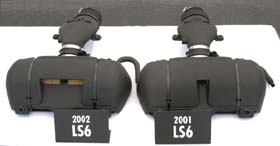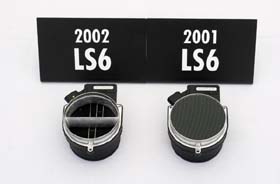Induction and Calibration Upgrades
More airflow from the new cam and less back-pressure
from the new cats drove some other improvements on the induction side. For
MY02, LS6 gets another, new air filter assembly. It’s similar to the ’01
unit, in that it has an additional air intake opening on its cover, but
the extra opening is larger.
 |
A
side-by-side of the ’02 and ’01 air filter assembly
shows their differences. Image: Author
[Click Image for Larger View ] |
|
GM did what Idaho
Corvette Page regulars have been doing for years with MAFs–remove
the air flow straightener or "screen". What took them so
long to figure that one out? The LS6 is not GM’s only application
of that MAF. Any use of it with an air intake duct that curves just
before the MAF (typical of most trucks), needs the straightener for
the MAF to sense accurately and GM’s conventional wisdom was to
leave it in on Corvettes. In part, the essence of the ruthless
pursuit of power is whipping conventional wisdom which was,
according to Dr. John, "....you gotta have it in
there." |
With the Corvette’s relatively straight passage
between the air filter box and the MAF, the straightener isn’t needed.
Juriga told us it wasn’t until the MY02 development that his people
looked at that MAF in a Corvette-specific perspective. "The
questions we continually ask are: ‘Do we need it?’, ‘What’s next?’
and ‘What if?’
"The low-hanging fruit is gone," Juriga
continued, "as far as changes that make more power so you gotta
start going higher–you gotta go to the edge. That’s what the Corvette
is all about–pushing everything to the edge."
|
There were no changes to either the LS6’s
intake manifold or its cylinder heads. John Juriga: "The
intake manifold was already pretty darn good. We designed it to
handle additional flow rates and not require retool the very next
year because composite intakes are very expensive to retool and
develop. We made sure it would flow more air than we needed in the
first year. The same was true with the heads."
A change in engine air flow significant enough
to provide 20 more horsepower also demanded a small change in the
engine’s fuel and spark curves. This was done with slight
changes in the PCM calibration. There was no change in injectors
or fuel pressure. |
 |
The
two MAFs, screened and unscreened. That GM has done this for
’02 ought to prompt the folks who’ve yet to do it to
older Gen IIIs to remove their screens. Removing the screen
and using the ’02 air filter box together gets about 5hp
at airflow levels such as the LS6’s.
Image: Author [Click Image for Larger View ] |
|
We mentioned the calibration’s antipowerhop algorithm
earlier. Confronted with customer complaints and durability concerns about
the behavior of manual transmission Corvettes at launch, GM Powertrain has
added the feature to eliminate the hop. "The Power Hop algorithm
is used on manual transmission Corvettes, only." John Juriga
states. "If TCS (traction control system) is turned off, it
is possible to get the tires to break loose and have axle hop, or
oscillate, during hard launches. To remedy this, the TCS module requests a
torque reduction from the ECM, even though TCS has been turned off by the
driver. For Power Hop, spark and/or fuel (reductions are) used
rather than throttle to improve response time. This request is calibrated
so wheel hop can be reduced as much as possible without compromising
vehicle performance. The TCS module requests just enough torque reduction
for just long enough to get the axle back on the ground during these
launch events."